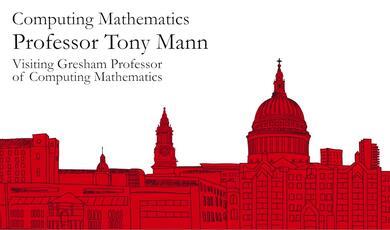Euler's Exponentials
Share
- Details
- Text
- Audio
- Downloads
- Extra Reading
Leonhard Euler was the most prolific mathematician of all time. He introduced the symbols e for the exponential number f for a function and i for √-1. He discovered what many mathematicians consider to be the most beautiful expression in mathematics, e ix = cosx + i sinx: a relation connecting the exponential and trigonometric functions. The exponential function and its inverse the logarithm function appear throughout mathematics and its applications, in physics, engineering, mathematical biology, chemistry and economics.
Download Text
Euler’s Exponentials
Professor Raymond Flood
Welcome and thank you for coming along.
In this talk I want to do several things. The first is to introduce the remarkable mathematician Leonhard Euler and then introduce one of the most important natural numbers – the number e. I will give some examples of where it arises naturally in exponential growth and decay. Then the finale is to show you a remarkable connection between the exponential and trigonometric functions and some of this connection’s beautiful consequences. Let me start by introducing Euler.
Leonhard Euler’s life can be conveniently divided into four periods spent in only three locations – Basel, St Petersburg, Berlin and then back to St Petersburg. He was born in Basel in Switzerland in 1707 and spent his early years in a village nearby where his father was a Calvinist pastor.
He entered the University of Basel when he was 14 and received instruction there from the great Johann Bernoulli who was then probably one of the world’s greatest mathematicians. Euler graduated in 1723.
He started to develop an international reputation when only 19 when he submitted an entry to the Royal Academy of Sciences in Paris for a competition on the best way to position the masts on a sailing ship. Euler did not win the highest prize but did receive an honourable mention. In the future he would win the highest prize on no less than 12 occasions.
1727 was the year that his entry was published and was also the year that he moved to a professorship in St. Petersburg. It was also the year that Isaac Newton died.
The St. Petersburg Academy had been founded by Peter the Great and was part of his plan to reform the Russian educational system and open Russia to the world. He stayed in St. Petersburg until 1741 when because of the political turmoil in Russia he accepted an offer to move to the Berlin Academy where he was initially very satisfied until friction developed between him and Frederick the Great which resulted in Euler, in 1766, returning to the St. Petersburg Academy. Russia was now ruled by Catherine the Great who was again like Peter the Great making education a priority for the Russian Government. Euler stayed in St. Petersburg until he died in 1783.
Here I have gathered together several portraits of Euler. On the left we have a painting from when Euler was about 30. In the middle there are two portraits of him when he was in his forties and on the right a portrait of him in his early seventies about five years before his death. During his first spell in St. Petersburg he married producing thirteen children only five of whom survived past childhood and of those five just three outlived their parents. Euler had health problems of his own. By his early thirties he had lost the vision in his right eye. As we will see it did not affect his productivity and even the loss of sight of his other eye in 1771 leaving him essentially blind did not seem to slow down his prodigious mathematical output. In fact during this time of essentially total blindness he produced some of his most important work.
Euler had an amazing memory, was able to hold many abstract ideas in his head simultaneously and was also able to undertake staggering calculations in his head.
The mathematician Francois Arago wrote:
Euler calculated without apparent effort, as men breathe, or as eagles sustain themselves in the wind.
Euler kept working on mathematics until the day he died as was described by the Marquis de Condorcet in his eulogy for Euler:
He had retained all his facility of thought, and, apparently, all his mental vigour. No decay seemed to threaten the sciences with the sudden loss of their great ornament. On the 7th September, 1783, after amusing himself with calculating on a slate the laws of the ascending motion of air-balloons, the recent discovery of which was then making a noise all over Europe he dined with Mr Lexell and his family, talked of Herschel’s planet (the recently discovered Uranus), and of the calculations which determine its orbit. A little after he called his grandchild, and fell a playing with him as he drank tea, when suddenly, the pipe, which he held in his hand, dropped from it, and he ceased to calculate and to breathe.
But why did Condorcet call Euler science’s “great ornament”. To give some indication of why let me consider Euler’s work under the three dimensions of quantity, range and significance.
First of all: quantity. He produced over eight hundred books and papers in a wide range of areas that I will come to shortly.
Indeed 228 of Euler’s papers were published after he died making the deceased Euler still one of the world’s most prolific mathematicians!
The publication of his collected works by the Euler Commission in Switzerland began in 1911 and to date 76 volumes have been published.
Three volumes of his correspondence have been published and several more are in preparation.
At the bottom of the slide there is a screenshot of the very useful Euler archive website maintained by a group of scholars and hosted by the Mathematical Association of America.
In the Euler archive you can access a list of 866 of Euler’s books and papers. You can also choose to see the titles in English. Here I have just taken a screen shot of 19 of them – just over 2% of them – to give some indication of his range.
225 General principles concerning the state of the equilibrium of fluids
226 General principles concerning the motion of fluids
227 Continuation into the research on the theory of the motion of fluids
228 On numbers which are the sum of two squares
229 On the construction of the best gears
230 Elements of the doctrine of solids
231 Proof of some of the properties of solid bodies enclosed by planes
232 On the movement of celestial bodies perturbed by any number of forces
233 Refined studies into the effect of windmills
234 Experiments to determine the refraction of all types of transparent liquors
235 On the action of saws
236 Explanation of certain paradoxes in integral calculus
237 Research concerning the declination of the magnetized needle
238 Concerning the strength of columns
239 General rules for the construction of telescopes and microscopes, using some general number of lenses.
240 Research into glasses with three lenses which represent inverted objects
241 Proof of a theorem of Fermat that every prime number of the form 4n+1 is the sum of two squares
His range was from such ‘pure’ topics as number theory, combinatorics and the geometry of a circle, via mechanics, logarithms, infinite series and calculus, to such practical concerns as optics, astronomy and the stability of ships.
But quantity and range are not the most important dimensions of Euler’s activity. Of greater importance was the significance of his work. So many crucial and core ideas in mathematics can be traced back to his work.
He introduced the symbols e for the exponential number, f for a function and i for √−1.
Let me look at some other contributions that Euler made to mathematics.
While at St Petersburg, Euler became interested in infinite series. It is the case that the ‘harmonic series’ of reciprocals,
(1 + 1/2 + 1/3 + 1/4 + 1/5 + . . . + 1/n)
has no finite sum, but Euler noticed that adding the first n terms of this series (up to 1/n) gives a value very close to loge n. In fact, as he demonstrated, the difference between them,
(1 + 1/2 + 1/3 + 1/4 + 1/5 + . . . + 1/n) – loge n,
tends to a limiting value close to 0.577, now called Euler’s constant.
Another difficult problem of the time involving infinite series was known as the Basel problem and was to find the sum of the reciprocals of the perfect squares:
1 + 1/4 + 1/9 + 1/16 + 1/25 + . . . ;
the answer was known to be about 1.645, but no-one could find its exact value. Euler achieved fame by showing that the sum is π2/6. He then extended his calculations, ingeniously finding the sum of the reciprocals of all the 4th powers (π4/90), the 6th powers (π6/945), and so on, right up to the 26th powers!
On the right we have the title page of Euler’s Introduction to the Analysis of Infinite Quantities of 1748 which discussed infinite series, partitions of numbers, the exponential function, the properties of conics, and many other topics. This book is the first it is sometimes said that looks modern to our eyes. It makes the concept of function central to mathematical analysis rather than that of curves and in it Euler introduces the special types of functions – polynomial, trigonometric, exponential and logarithmic – that are still centre stage in mathematical analysis. He found some of the most beautiful formulae in mathematics and although modern mathematics is now more concerned with concepts and structures its most important results frequently still involve formulae.
In 1755, he published a massive work on the differential calculus, reformulating the subject in terms of the idea of a function and giving the latest results, many due to him. He followed this with an influential three-volume work on the integral calculus.
Euler was a gifted author and expositor. His books are very readable.
His best-known work, still in print today, was his Letters to a German Princess, a survey of popular science and philosophy written for the layperson. The slide shows volume 2 of a subsequent English translation and on the right there is one of the plates illustrating Euler’s discussion of static electricity or in his terms positive or negative electricity.
Possibility Euler’s most celebrated achievement was to link the exponential function with the trigonometric functions and that is my main topic for this lecture.
You have probably heard of ‘exponential growth’, meaning something that grows very fast. Such growth arises in connection with compound interest or population growth, while there is ‘exponential decay’ in the decay of a radioactive element, say uranium, or the cooling of a cup of coffee.
Exponential expressions are expressions such as 2n or 3n and they grow very quickly as n grows.
In fact, mathematicians usually consider, not 2n or 3n, but en, where e = 2.6182818… .
The reason that e is used is because it arises naturally in growth. Let me illustrate using compound interest.
- Invest £1
- Interest rate 100%
Interest applied each
Sum at end of the year
Year
£2.00000
Half-year
£2.25000
Quarter
£2.44141
Month
£2.61304
Week
£2.69260
Day
£2.71457
Hour
£2.71813
Minute
£2.71828
Second
£2.71828
The graph shows the sum returned against different interest rates compounded continuously. I have picked out the result we have already seen that if the interest rate is 100% the sum returned is £e.
Here is the exponential function again but now for some negative as well as positive values of x. Another important property of the number e is that the slope of the tangent to this curve above x is also ex. Another way of saying this is that the rate at which it is increasing at time x is just its current value.
Take the annual interest to be 100%.
Let n be the number of time periods with interest of 100n% compounded at the end of each time period.
Then the accumulated sum at the end of a year is:
(1+ 1n )n
In the limit as n increases this becomes:
e = 1+ 11 + 12×1 + 13×2×1 + 14×3×2×1 + 15×4×3×2×1 + ×××
Or using factorial notation
e = 1+ 11! + 12! + 13! + 14! + 15! + 16! + 17! + ×××
The factorial notation which uses an exclamation mark is useful. For example 5! = 5×4×3×2×1.
In the same way that we have just calculated e as the limit of
(1+ 1n )n
We can calculate ex as the limit of
(1+ xn )n
We get
e1
= 1+ 11! + 12! + 13! + 14! + 15! + 16! + 17! + ×××
ex = 1+ x1! + x22! + x33! + x44! + x55! + x66! + x77! + ×××
In the same way that we can have exponential growth we can have exponential decay. This is just the graph of e-x rather than ex.
One situation in which exponential decay arises naturally is in Newton’s Law of Cooling.
Newton’s Law of Cooling says that the rate of loss of heat from a body is proportional to the excess temperature of the body over the temperature of its surroundings. Here I have applied Newton’s Law of Cooling to a cup of coffee which is initially at 80°C in a room whose temperature is 20°C. So the excess temperature when the coffee is made is 60° and we see that on the vertical axis. As time passes the coffee gets cooler and the excess temperature approaches 0.
This exponential decay curve has a very interesting property. This is that the time for the excess temp to halve from any value is always the same! If we start with an excess temperature of 60° we can use the graph to show that it takes 25 minutes for the excess temperature to drop to 30°.
Then again from the graph we see that it takes until 50 minutes for the excess temperature to halve again to 15°. So it takes another 25 minutes to drop from 30° to 15°.
Doing it once more and finding how long it takes the excess temperature to fall from 15° to 7.5° we see that it happens after 75 minutes so 25 minutes again after it was at 15°.
The concept of half-life is also applied to radioactive decay.
We can also apply Newton’s Law of Cooling to the following problem.
You have just made a cup of coffee which you want to drink white. Sadly the phone goes and you are not able to drink the coffee for several minutes. You want your coffee to be as hot as possible when you eventually are able to drink it. Should you add the milk before lifting the phone or when you return after the phone call?
There are two different arguments you could use here to make a decision. You could say that the hotter the coffee is, the greater its heat loss, so add the coffee right away to reduce the heat loss during the cooling.
But on the other hand, the milk is at a lower temperature than the coffee and the mixing effect on adding the milk reduces the temperature of the coffee and the hotter the coffee is the greater the reduction. That is the hotter the coffee is when you add the milk the larger the reduction in temperature so it might be better to leave adding the milk as long as possible. That is, after your phone call.
We need to use our exponentials to decide between the two strategies:
- add milk before you go to the phone or
- wait till you return.
It turns out the strategy to get the hottest coffee depends on the temperature of the milk.
The red graph is what happens if milk is added at the start. There is an immediate drop in temperature due to the mixing effect then Newton’s Law of Cooling kicks in and the coffee cools exponentially. The green graph shows what happens if the milk is added after 30 minutes. The coffee cools exponentially due to Newton’s Law of Cooling. Then at 30 minutes the milk is added and we can see that the temperature drops down to what it is on the red curve. So it does not matter when you add the milk if it is at room temperature.
Again the red graph is adding straight away and the green is adding latter. This time adding the milk straight is the approach to take to keep your coffee hottest.
But the opposite is true if the milk is above room temperature. For example, suppose the milk is at 35° then when we do the calculations we find that it is best to add the milk when you return from your phone call.
I suppose this result is somewhat intuitive: if the milk is warm, add it later, and if it is cold add it right away.
I have made a lot of simplifying assumptions in this modelling. Some of these simplifying assumptions, such as that the volume heat capacity of milk and black coffee are the same and close to that of water, turn out not to be too crucial. But there is one that is.
It is that black coffee and white coffee cool at different rates. In fact black coffee cools significantly faster than white coffee, by about 20%. This affects the strategy to adopt and is analysed is this paper On cooling tea and coffee by two physicists.
As they say in the abstract to the paper:
Factors influencing the rate of cooling of hot coffee and tea have been investigated theoretically and studied experimentally using deliberately “domestic” apparatus. It is demonstrated that black coffee cools faster than white coffee under the same conditions. Under most (but not all) circumstances, if coffee is to be as hot as possible several minutes after its preparation, any milk or cream should be added immediately, rather than just before drinking.
They conjecture that the mechanism causing the difference in cooling rates is a reduction in evaporation rate when milk is present in the coffee.
Possibly Euler’s most celebrated achievement was to link the exponential function with the trigonometric functions and a consequenc of that is this beautiful identity
eiπ + 1 = 0.
linking five of the most important constants in mathematics:
0 which when added to any number leaves the number unchanged
1 which multiplied by any number leaves the number unchanged
The number π which is the ratio of the circumference of a circle to its diameter
e of the exponential function which we have defined above
i which is the square root of -1
Before showing you how Euler derived his profound connection between the exponential and trigonometric functions I want to define the number i.
Euler worked with this type of number a great deal and said:
Of such numbers we may truly assert that they
are neither nothing, nor greater than nothing,
nor less than nothing, which necessarily
constitutes them imaginary or impossible.
Even in the early 19th century there was still a great deal of unhappiness about complex or so-called ‘imaginary’ numbers that don’t seem to exist.
It was William Rowan Hamilton who finally provided an explanation of complex numbers that was generally accepted. He proposed that the complex number should be defined as a pair (a, b) of real numbers.
We combine such pairs (a, b) and (c, d) by using the following rules:
Addition:
(a, b) + (c, d) = (a + c, b + d);
Multiplication:
(a, b) x (c, d) = (ac - bd, ad + bc);
For example (1, 2) × (3, 4) = (3 – 8, 4 + 6) = (-5, 10)
The pair (a, 0) then corresponds to the real number a,
the pair (0, 1) corresponds to the
imaginary number i = -1,
and we have the equation
(0, 1) x (0, 1) = (-1, 0),
which corresponds to the equation i x i = - 1.
In this representation, called the complex plane, two axes are drawn at right angles – the real axis and the imaginary axis – and the complex number a + b -1 is represented by the point at a distance a in the direction of the real axis, which is horizontal, and at height b in the direction of the imaginary axis, which is vertical.
This animation depicts points moving along the graphs of the sine function (in blue) and the cosine function (in green) corresponding to a point moving around the unit circle. The sine is the vertical displacement of the moving point from the horizontal axis and the cosine is the horizontal displacement of the moving point from the vertical axis.
I’ve defined the sine and cosine geometrically but what Euler did was to obtain an algebraic expression for them in terms of infinite power series.
Euler used what we now call De Moivre’s formula and the binomial theorem to obtain an express for the cosine of a multiple of an angle in terms of the cosine and sine of the angle.
cosnθ= (cosθ)n - n(n-1)1∙2 (cosθ)n-2 (sinθ)2+ ∙∙∙
Then Euler went to the limit! He supposed θ to be infinitely small and n infinitely great so that their product nθ is finite and equal to x say. This allowed him to replace cos θ by 1 and sin θ by θ.
Substituting this into the formula gives a series expansion for cos x and in a similar way he obtained one for sin x.
cos x = 1 - x22! + x44! - x66! + x88! - x1010! + x1212! + ×××
sin x = x - x33! + x55! - x77! + x99! - x1111! + x1313! + ×××
And 𝑥 is measured in radians.
Now at last we can obtain the jewel in the crown – Euler’s formula!
cos x = 1 - x22! + x44! - x66! + x88! - x1010! + x1212! + ×××
i sin x =ix - i x33! + i x55! - i x77! +ix99! - i x1111! + i x1313! + ×××
Add to get
1 + ix - x22! - i x33! + x44! + i x55! - x66! - i x77! + x88! +ix99! ×××
which is;
eix = 1+ ix1! + (ix)22! + (ix)33! + (ix)44! + (ix)55! + (ix)66! + (ix)77! + ×××
Note: i2 = -1
i3 = - i
i4 = 1
i5 = i and so on.
A special case of this, relating the most important constants in mathematics, is obtained by putting x = π to get
eiπ = −1
or as I prefer to write it
eiπ + 1 = 0
Set x = p/2 in eix = cos x + i sin x
To get
eip/2 = i
Raise both sides to the power of I to get
ei i p/2 = ii
which is ii = 1eπ
an identity about which the mathematician Benjamin Peirce is reported to have said:
“… We have not the slightest idea of what this equation means , but we may be certain that it means something very important”
- Manipulation of symbolic expressions
Euler had a fantastic ability to manipulate symbolic expressions. We saw examples of his symbol manipulation in his work on the infinite series view of the exponential and trigonometric functions. Euler has the reputation of being probably the greatest symbol manipulator ever.
- Treating the infinite
He used infinitesimals – infinitely small quantities – and infinitely large quantities with a dexterity and sure footedness that is awe inspiring. We saw in his work on the series expansion for cosine how he would let one quantity become infinitely small and the other infinitely large but in such a way that their product remains constant! Mathematicians know that dealing with infinite processes and limits can give problems but Euler seemed to have an intuition that carried him through.
- Strategy
A favourite strategy of Euler was to view the same thing in two different ways. We saw how he showed a particular infinite series was the series for the complex exponential but could also be split into two other series which were the series for sine and cosine. This ability to view mathematical objects from different perspectives is one of Euler’s core strengths.
- Genius
Even having identified the three characteristics above it still requires a remarkable level of ingenuity and insight to develop new mathematical ideas and see their interconnections.
In the words of the great French mathematician Pierre-Simon Laplace:
Read Euler, read Euler, he is the master of us all.
I encourage you to make Euler, the Shakespeare of mathematics better known.
I’ll finish with an amusing observation that Tony Crilly makes about e in his book 50 mathematical ideas you really need to know. He tells us about the book on the right, a novel, Gadsby, of 50,000 words written without using the letter e. As Tony notes it is hard to imagine a mathematician setting out to write an e-less textbook, or being able to do so!
Happy Christmas and look forward to seeing you in January.
© Professor Raymond Flood, 17 November 2014
This event was on Tue, 18 Nov 2014
Support Gresham
Gresham College has offered an outstanding education to the public free of charge for over 400 years. Today, Gresham College plays an important role in fostering a love of learning and a greater understanding of ourselves and the world around us. Your donation will help to widen our reach and to broaden our audience, allowing more people to benefit from a high-quality education from some of the brightest minds.


 Login
Login







